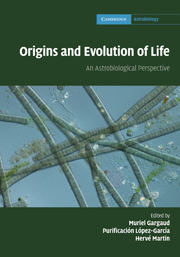Book contents
- Frontmatter
- Contents
- List of contributors
- Foreword
- Preface
- Part I What is life?
- Part II Astronomical and geophysical context of the emergence of life
- 6 Organic molecules in the interstellar medium
- 7 Cosmochemical evolution and the origin of life: insights from meteorites
- 8 Astronomical constraints on the emergence of life
- 9 Formation of habitable planets
- 10 The concept of the galactic habitable zone
- 11 The young Sun and its influence on planetary atmospheres
- 12 Climates of the Earth
- Part III The role of water in the emergence of life
- Part IV From non-living systems to life
- Part V Mechanisms for life evolution
- Part VI Life in extreme conditions
- Part VII Traces of life and biosignatures
- Part VIII Life elsewhere?
- Index
6 - Organic molecules in the interstellar medium
from Part II - Astronomical and geophysical context of the emergence of life
Published online by Cambridge University Press: 04 February 2011
- Frontmatter
- Contents
- List of contributors
- Foreword
- Preface
- Part I What is life?
- Part II Astronomical and geophysical context of the emergence of life
- 6 Organic molecules in the interstellar medium
- 7 Cosmochemical evolution and the origin of life: insights from meteorites
- 8 Astronomical constraints on the emergence of life
- 9 Formation of habitable planets
- 10 The concept of the galactic habitable zone
- 11 The young Sun and its influence on planetary atmospheres
- 12 Climates of the Earth
- Part III The role of water in the emergence of life
- Part IV From non-living systems to life
- Part V Mechanisms for life evolution
- Part VI Life in extreme conditions
- Part VII Traces of life and biosignatures
- Part VIII Life elsewhere?
- Index
Summary
Introduction
At one end, the Earth, we have complex molecular structures giving rise to life; at the other end, the diffuse interstellar medium (hereinafter ISM), we have atoms floating in an almost empty space. How, when and where did the transition from unbound atoms to complex molecular structures occur? Had it occurred already in the dense molecular-cloud phase of the ISM and/or during the formation and evolution of the protosolar nebula? These are the questions whose answers will help in understanding whether, as the Nobel prizewinner C. De Duve wrote, ‘The building blocks of life form naturally in our galaxy and, most likely, also elsewhere in the cosmos. The chemical seeds of life are universal’ (De Duve, 2005). What we know for sure is that a long process, of a few billions years, brought matter from the diffuse state of the ISM to the condensed state of planets (Earth), comets and meteorites (see Chapter 7 of this volume). We also know that primitive meteorites, the oldest fossils we have from the Solar-System formation aeons, contain the ‘seeds of life’ that De Duve alluded to: amino acids.
In this chapter we will show that the formation process of solar-type stars, while bringing matter from a diffuse to a condensed state, also leads to increasing molecular complexity. Although solar-type star-forming regions are not the only places in the ISM where organic molecules are found, two reasons lead us to focus here on them: (1) they are among the places with the richest harvest of organic molecules; and (2) they are regions similar to our Solar-System progenitor, so that the organic chemistry observed there is directly linked to the possible inheritance of terrestrial life from the ISM.
- Type
- Chapter
- Information
- Origins and Evolution of LifeAn Astrobiological Perspective, pp. 85 - 97Publisher: Cambridge University PressPrint publication year: 2011
- 1
- Cited by



